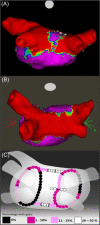Posterior wall isolation in persistent atrial fibrillation feasibility, safety, durability, and efficacy
- PMID: 35598313
- PMCID: PMC9543717
- DOI: 10.1111/jce.15556
Posterior wall isolation in persistent atrial fibrillation feasibility, safety, durability, and efficacy
Abstract
Introduction: Posterior wall isolation (PWI) added to pulmonary vein isolation (PVI) is increasingly used despite limited evidence of clinical benefit. We investigated the feasibility, durability, and efficacy of index-procedure PVI + PWI radio frequency ablation (RFA) in patients with persistent atrial fibrillation (PeAF).
Methods and results: Twenty-four patients with PeAF participated in the prospective PeAF-Box study and underwent RFA with wide area circumferential ablation, roof- and inferior lines to achieve PVI + PWI at index procedure. Follow-up included monitoring by an implantable cardiac monitor, esophagoscopy and mandated invasive lesion-reassessment at 6 months. PWI was achieved at minor procedural cost in all patients following PVI. In 33% of patients a median of three ablations in the narrow zone between the center of the posterior wall (PW) and the posterior right carina was pivotal for swift achievement of PWI. At the 6-month reassessment procedure 85% (95% confidence interval [CI]: 77%-92%) of pulmonary veins (PVs) and 46% (95% CI: 26%-67%) of PWs remained durably isolated. AF recurred in 25% and was associated with PV-reconnection (p = .02) but not PW-reconnection (p = .27). AF-burden was 0% (interquartile range [IQR]: 0%-0%) overall and after recurrence 1% (IQR: 0%-7%).
Conclusion: Index procedure PVI + PWI for PeAF was feasible when recognizing that limited ablation in a PW center-to-right-carina zone was required in a subset of patients. Despite limited chronic PWI durability this strategy was followed by low AF-burden. A PVI + PWI strategy appears promising in ablation for PeAF.
Trial registration: ClinicalTrials.gov NCT05045131.
Keywords: AF burden; center-right zone (of left atrial posterior wall); implanted continuous rhythm monitor; mandated invasive reassessment; persistent atrial fibrillation; posterior wall.
© 2022 The Authors. Journal of Cardiovascular Electrophysiology published by Wiley Periodicals LLC.
Figures



Comment in
-
Left atrial posterior wall isolation-The conundrum of safety versus efficacy.J Cardiovasc Electrophysiol. 2022 Aug;33(8):1675-1677. doi: 10.1111/jce.15557. Epub 2022 May 28. J Cardiovasc Electrophysiol. 2022. PMID: 35598312 No abstract available.
References
-
- Bai R, Di Biase L, Mohanty P, et al. Proven isolation of the pulmonary vein antrum with or without left atrial posterior wall isolation in patients with persistent atrial fibrillation. Heart Rhythm. 2016;13:132‐140. - PubMed
-
- Chilukuri K, Scherr D, Dalal D, et al. Conventional pulmonary vein isolation compared with the ‘box isolation’ method: a randomized clinical trial. JIntervCard Electrophysiol. 2011;32:137‐146. - PubMed
-
- Thiyagarajah A, Kadhim K, Lau DH, et al. Feasibility, safety, and efficacy of posterior wall isolation during atrial fibrillation ablation: a systematic review and meta‐analysis. Circ Arrhythm Electrophysiol. 2019;12:e007005. - PubMed
-
- Spertus J, Dorian P, Bubien R, et al. Development and validation of the atrial fibrillation effect on QualiTy‐of‐Life (AFEQT) questionnaire in patients with atrial fibrillation. Circ Arrhythm Electrophysiol. 2011;4:15‐25. - PubMed
MeSH terms
Associated data
LinkOut - more resources
Full Text Sources
Medical
Research Materials

